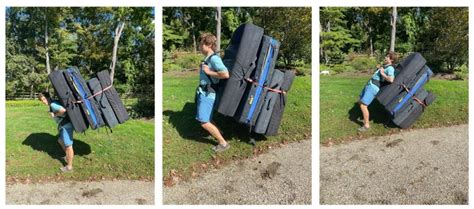Effortless Double Bouldering Pad Carrying Techniques
Carrying two bouldering pads can feel like a Herculean task, especially after a long session of intense climbing. But with the right techniques and a bit of practice, you can make this chore significantly easier and more comfortable. This article will explore several methods for effortlessly carrying double bouldering pads, saving you energy and preventing strain.
Why Carry Two Bouldering Pads?
Before diving into carrying techniques, let's briefly address why climbers often opt for two pads. A single pad might suffice for low-to-the-ground problems, but taller climbs require more landing area for safety. Two pads offer significantly improved protection, reducing the risk of injury and providing a softer landing. The added cushioning also benefits the climber by absorbing impact and reducing the chance of twisting ankles or knees.
The Traditional "Shoulder Sling" Method
This is the most common method, often adopted by beginners. It involves slinging one pad over each shoulder, with the pads resting across your back.
Advantages:
- Simple and intuitive to learn.
- Distributes weight relatively evenly.
Disadvantages:
- Can be uncomfortable over long distances.
- Restricts arm movement.
- Pads can shift and become unbalanced.
- Not ideal for carrying additional climbing gear.
Tip: Securely fasten straps to prevent slipping. Consider using extra padding or a shoulder harness for added comfort.
The "Backpack" Method
This method requires a bit more coordination but significantly improves comfort and weight distribution.
How to Do It:
- Place one pad vertically against your back, securing it with straps.
- Place the second pad on top, slightly overlapping the first.
- Secure both pads using straps, creating a makeshift backpack.
Advantages:
- Keeps both hands free for carrying other items like ropes, shoes, or chalk bags.
- More comfortable for longer distances compared to shoulder-slinging.
- Offers better weight distribution.
Disadvantages:
- Requires more practice to achieve a balanced setup.
- Can restrict upper body movement.
- May not be suitable for all pad designs.
The "Lugging" Method (for shorter distances)
For short distances between your car and the climbing area, this is a quick and straightforward approach.
How to Do It:
- Securely grasp the handles of both pads.
- Carry the pads close to your body, distributing weight evenly.
Advantages:
- Quick and easy for short distances.
- Simple to execute.
Disadvantages:
- Not recommended for long distances due to strain on your arms and back.
- Doesn't leave hands free for other gear.
Using a Dedicated Bouldering Pad Carrier
Investing in a dedicated bouldering pad carrier is a worthwhile investment for serious climbers. These carriers are designed for maximum comfort and weight distribution, often featuring padded straps, multiple carrying options, and compartments for additional gear.
Advantages:
- Maximum comfort and weight distribution.
- Hands-free carrying.
- Additional storage for other climbing essentials.
Disadvantages:
- Adds initial cost.
- Requires carrying an additional piece of equipment.
How to Choose the Right Method
The best method for carrying double bouldering pads depends on several factors, including:
- Distance: For longer distances, a backpack method or dedicated carrier is preferable. For short distances, the lugging method might suffice.
- Pad Type: The design and weight of your pads will influence the best carrying technique.
- Additional Gear: If you're carrying other gear, a backpack method or dedicated carrier is more practical.
- Personal Preference: Experiment with different techniques to find what feels most comfortable and efficient for you.
Preventing Injuries When Carrying Bouldering Pads
Regardless of the chosen method, it’s vital to prioritize proper posture and weight distribution to prevent injuries:
- Maintain good posture: Stand tall with your shoulders relaxed and back straight.
- Distribute weight evenly: Avoid favoring one side.
- Take breaks: If carrying pads over a long distance, take regular breaks to rest and adjust your load.
- Use padding: Consider extra padding or a harness for added comfort and protection.
By mastering these techniques and prioritizing safety, you can transform the chore of carrying double bouldering pads into a manageable and comfortable part of your climbing routine. Happy climbing!

